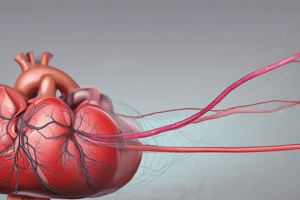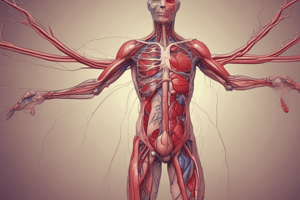Podcast
Questions and Answers
What is the main function of veins in the circulatory system?
What is the main function of veins in the circulatory system?
- To return blood to the right atrium (correct)
- To distribute oxygenated blood to tissues
- To filter blood toxins before reaching the heart
- To increase blood pressure in the systemic circulation
What anatomical characteristic of veins contributes to their low resistance?
What anatomical characteristic of veins contributes to their low resistance?
- Thick muscular walls
- Presence of valves only
- Larger vessel diameter (correct)
- High density of red blood cells
Which statement accurately describes the pressure gradient necessary for venous return?
Which statement accurately describes the pressure gradient necessary for venous return?
- Pressure gradient must exist; higher pressure in veins than in the right atrium (correct)
- Venous pressure must be equal to right atrial pressure
- Higher pressure in the right atrium than in veins
- Venous pressure must be significantly lower than arterial pressure
What percentage of total blood volume is typically found in the venous system?
What percentage of total blood volume is typically found in the venous system?
How do veins act as reservoirs in the circulatory system?
How do veins act as reservoirs in the circulatory system?
Flashcards are hidden until you start studying
Study Notes
Overview of Venous Return
- Venous return refers to the flow of blood back to the heart from systemic circulation.
- Approximately 61-65% of total blood volume resides in the venous system.
Characteristics of Veins
- Compliance: Veins are capable of stretching to accommodate varying amounts of blood, resulting in lower pressure within the venous system.
- Resistance: Due to their larger diameter, veins have low resistance, facilitating easier blood flow compared to arteries.
Function of Veins
- The primary function of veins is to return deoxygenated blood to the right atrium of the heart.
- Veins serve as reservoirs, enabling the adjustment of blood flow based on physiological demands (e.g., during exercise).
Pressure Dynamics in Venous Return
- A pressure gradient is essential for blood flow; veins maintain higher pressure relative to the right atrium.
- The normal pressure range in venules is lower than that in arterial systems, aiding in the effective return of blood to the heart.
Studying That Suits You
Use AI to generate personalized quizzes and flashcards to suit your learning preferences.




